China Development Financial Bundle
Who Really Controls China Development Financial Company?
Unraveling the China Development Financial SWOT Analysis reveals the critical importance of understanding a company's ownership structure. Knowing who owns China Development Financial Company (CDFC) is paramount for investors, analysts, and anyone seeking to understand its strategic direction and long-term potential. This knowledge is especially vital in the dynamic landscape of Chinese financial institutions and global markets.
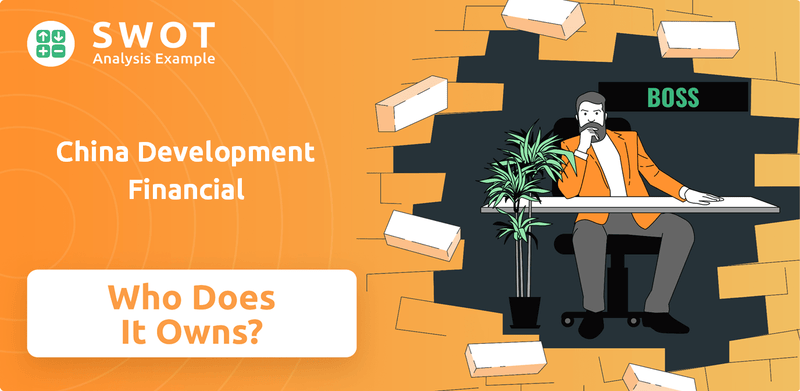
The evolution of CDFC ownership, from its inception to its current form as KGI Financial Holding Co., Ltd., offers a fascinating case study. Understanding the key investors and the influence they wield is essential for anyone tracking the company's performance. This exploration will provide insights into the history of ownership, the current shareholders, and the implications for the future of this significant financial player, addressing questions like "Who owns CDFC" and "Who is the major shareholder of China Development Financial Company."
Who Founded China Development Financial?
The genesis of China Development Financial Company (CDFC) traces back to 1959, with the establishment of China Development Corporation. This entity was a collaborative effort, involving the Economic Stabilization Committee of the Executive Yuan, the World Bank, and public capital. The initial vision was to create a financial institution focused on direct investments, setting the stage for its future.
The Koo Family, led by Jeffrey Koo Sr., played a pivotal role in founding the company. The early structure of CDFC combined public and private capital, reflecting a national development objective. This initial blend of ownership set the tone for its evolution into a significant player in Chinese financial institutions.
In 1999, China Development Corporation was restructured, becoming China Development Industrial Bank (CDIB). This was a crucial step in its modernization. Subsequently, in December 2001, China Development Financial Holding Co., Ltd. (CDF) was established through a stock swap, with CDIB Capital Group playing a key role. The Koo Family's influence has been enduring, with Angelo Koo currently chairing the company, highlighting their significant ownership stake.
The company's roots lie in 1959 with the establishment of China Development Corporation.
Jeffrey Koo Sr. and the Koo Family were instrumental in the company's founding.
Early ownership involved a mix of public capital and international entities like the World Bank.
In 1999, the company was restructured into China Development Industrial Bank (CDIB).
China Development Financial Holding Co., Ltd. (CDF) was established in December 2001.
Angelo Koo, a member of the Koo family, currently chairs the company.
The early ownership structure of CDFC involved a combination of public and private investment, with the Koo Family holding a significant stake. The focus on direct investments from the outset shaped its development-oriented financial structure. For more insights into the company's strategic direction, consider exploring the Growth Strategy of China Development Financial. This early ownership model has evolved over time, but the influence of the founding family and the initial development-focused mission remain central to understanding who owns CDFC and its strategic goals.
China Development Financial SWOT Analysis
- Complete SWOT Breakdown
- Fully Customizable
- Editable in Excel & Word
- Professional Formatting
- Investor-Ready Format
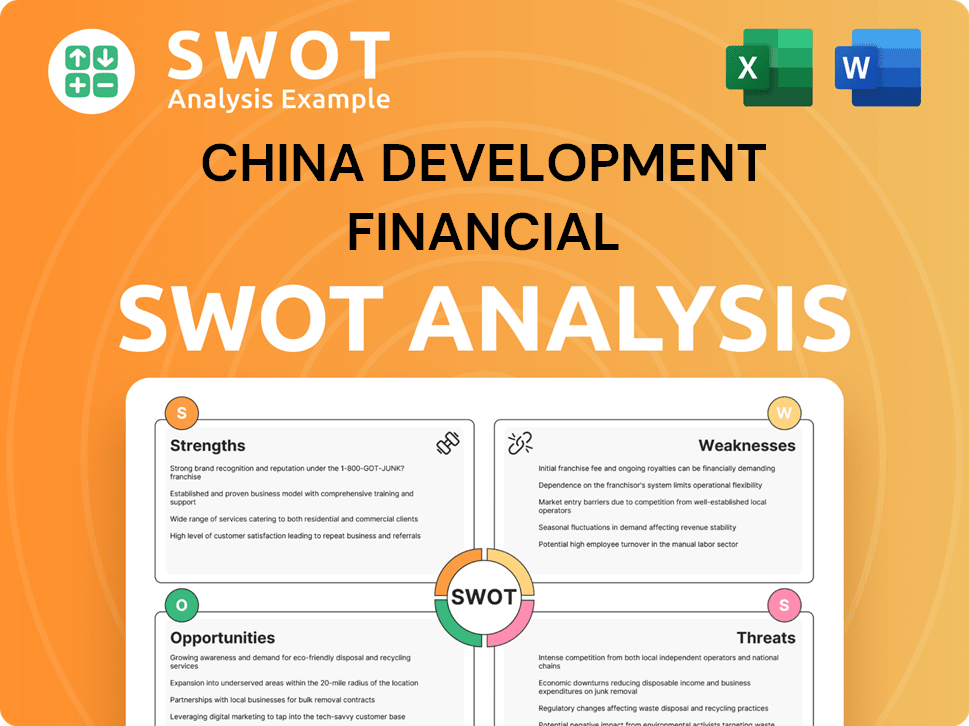
How Has China Development Financial’s Ownership Changed Over Time?
The ownership structure of China Development Financial Holding (now KGI Financial Holding) has seen significant changes since its inception. Following its initial public offering on the Taiwan Stock Exchange in December 2001, the company expanded through strategic mergers and acquisitions. A pivotal moment was the public acquisition of KGI Securities in 2012 for NT$54.6 billion, which was the largest merger in Taiwan's history at that time. Further expansion included the acquisition of Cosmos Bank for NT$23.09 billion in 2014, which later became KGI Commercial Bank. These strategic moves were essential in shaping the company's current structure and market position.
In September 2017, China Life (renamed KGI Life in 2024) became an integral part of the group, and in October 2021, CDF completed the acquisition of all remaining China Life stock. These acquisitions and mergers have facilitated the company's growth and diversification within the financial sector. These changes have profoundly affected the company's strategy, enabling it to offer a more comprehensive range of financial services, including banking, securities, private equity, venture capital, and life insurance, and solidifying its market position as a leading financial holding company in Taiwan.
| Shareholder | Equity Ratio (May 26, 2025) | Notes |
|---|---|---|
| Shin Wen Investment Co., Ltd. | 2.86% | Institutional Investor |
| Jing Kwan Investment Co., Ltd. | 2.56% | Institutional Investor |
| Labor Pension Fund | 1.97% | Government-related Fund |
| Bank of Taiwan | 1.71% | Government-related Fund |
| JPMorgan Chase Bank N.A., Taipei Branch in custody for Vanguard Total International Stock Index Fund | 1.32% | Institutional Investor |
| Vanguard Emerging Markets Stock Index Fund | 1.2% | Institutional Investor |
| Norges Bank | 1.14% | Institutional Investor |
| Jing Hui Investment Co., Ltd. | 1.07% | Institutional Investor |
As of May 26, 2025, KGI Financial Holding's major stakeholders include a diverse group of institutional investors and investment companies. Key shareholders with over 1% equity include Shin Wen Investment Co., Ltd., Jing Kwan Investment Co., Ltd., and others like the Labor Pension Fund and the Bank of Taiwan. The presence of these shareholders reflects a shift towards a diversified shareholder base. For more details on the company's growth strategy, you can refer to the Growth Strategy of China Development Financial.
The ownership of China Development Financial Company (CDFC) has evolved significantly, marked by strategic acquisitions and a shift towards a diversified shareholder base.
- Major shareholders include institutional investors and investment companies.
- The company's structure has been shaped by key acquisitions, including KGI Securities and Cosmos Bank.
- The evolution of CDFC's ownership reflects its growth and expansion in the financial market.
China Development Financial PESTLE Analysis
- Covers All 6 PESTLE Categories
- No Research Needed – Save Hours of Work
- Built by Experts, Trusted by Consultants
- Instant Download, Ready to Use
- 100% Editable, Fully Customizable
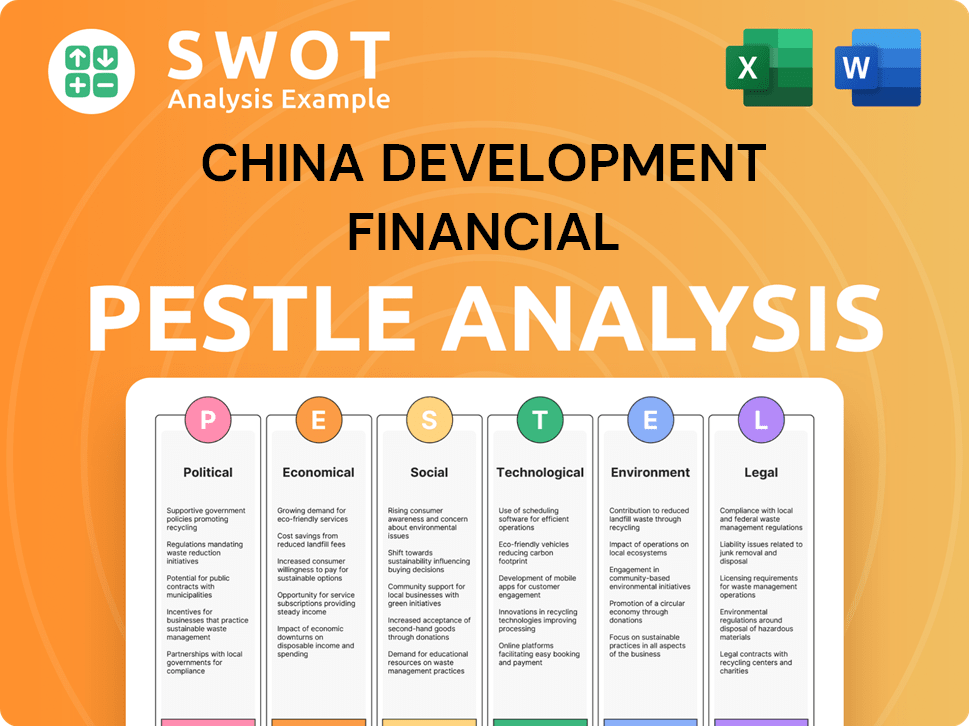
Who Sits on China Development Financial’s Board?
The current board of directors of KGI Financial Holding Co., Ltd. (formerly China Development Financial Company) boasts members with diverse expertise, encompassing banking, securities, insurance, and investment. As of April 26, 2024, Alan Wang holds the position of Chairman, while Paul Yang serves as President & CEO, both appointed by the Board. Alan Wang also chairs KGI Life Insurance, and Paul Yang chairs KGI Bank. Other key board members include Yu-Ling Kuo, Jenny Huang, Kiki Shih, and Independent Director Dai-Bai Shen. The 23rd term Board of Directors, appointed on May 22, 2023, has a term from May 27, 2023, to May 26, 2026, and includes three independent directors and three female directors, demonstrating a commitment to diversity.
The composition of the board reflects a strategic blend of experience, ensuring robust oversight and governance. The board's performance evaluation for 2024, completed in March 2025, yielded 'excellent' ratings across all items, indicating a stable governance environment. This structure supports the company's operations and strategic direction within the landscape of Chinese financial institutions.
| Board Member | Title | Other Affiliations |
|---|---|---|
| Alan Wang | Chairman | Chairman of KGI Life Insurance |
| Paul Yang | President & CEO | Chairman of KGI Bank |
| Yu-Ling Kuo | Director | N/A |
The company's voting structure generally adheres to a one-share-one-vote principle. There is no public information suggesting the presence of dual-class shares, special voting rights, or golden shares that would grant outsized control to specific entities beyond their proportional shareholding. This structure ensures that CDFC ownership is transparent and aligned with standard corporate governance practices. For more insights, you can explore the Revenue Streams & Business Model of China Development Financial.
The board includes experienced professionals from various financial sectors.
- Board members have diverse backgrounds, ensuring comprehensive oversight.
- The board's performance evaluation for 2024 was rated as 'excellent'.
- The voting structure is based on a one-share-one-vote principle.
- There have been no recent governance controversies.
China Development Financial Business Model Canvas
- Complete 9-Block Business Model Canvas
- Effortlessly Communicate Your Business Strategy
- Investor-Ready BMC Format
- 100% Editable and Customizable
- Clear and Structured Layout
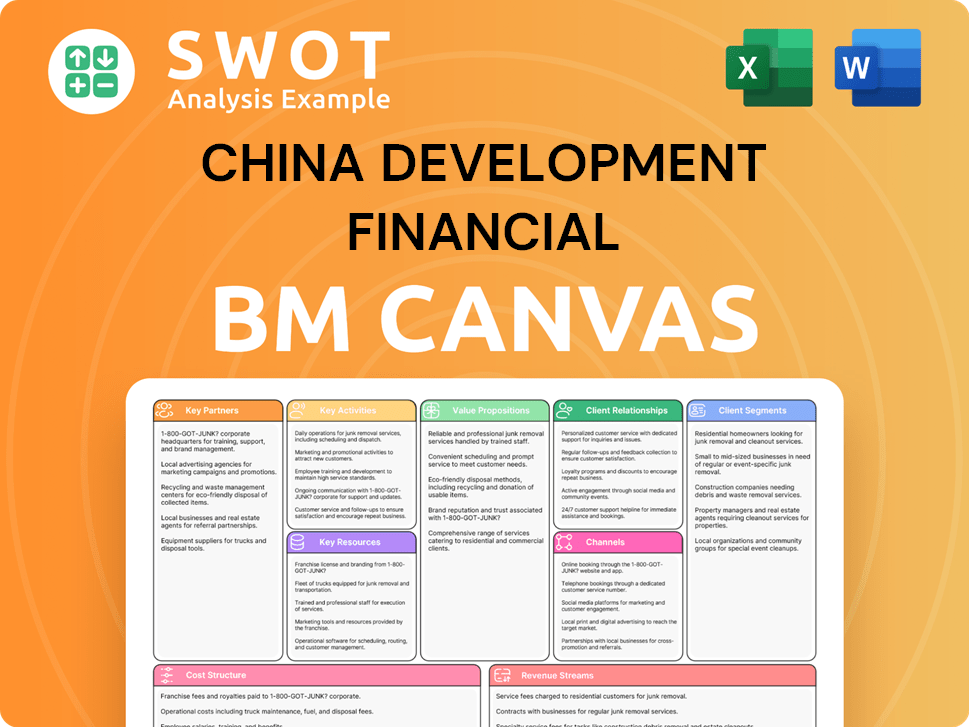
What Recent Changes Have Shaped China Development Financial’s Ownership Landscape?
Over the past few years, KGI Financial Holding (formerly China Development Financial Holding) has undergone significant changes in its ownership structure. A key development was the rebranding to KGI Financial Holding Co., Ltd. on October 9, 2024. This move aligns the brand with its subsidiaries, such as KGI Life (formerly China Life), which was renamed on January 1, 2024. These changes reflect a 'ONE KGI strategy' designed to integrate resources and services.
Regarding CDFC ownership, the company completed the acquisition of all remaining China Life stock in October 2021, making China Life Insurance a wholly-owned subsidiary. In July 2023, KGI SITE also became a wholly-owned KGI Financial subsidiary. Leadership changes have also occurred, with Alan Wang succeeding as Chairman and Paul Yang taking over as President & CEO in April 2024, following the retirement of former Chairman Su-Kuo Huang.
| Ownership Change | Date | Details |
|---|---|---|
| Rebranding | October 9, 2024 | Rebranded to KGI Financial Holding Co., Ltd. |
| China Life Acquisition | October 2021 | China Life Insurance became a wholly-owned subsidiary. |
| KGI SITE Acquisition | July 2023 | KGI SITE became a wholly-owned KGI Financial subsidiary. |
Industry trends, such as increased institutional ownership and consolidation, are evident in KGI Financial Holding's shareholder base. The company's focus on private equity funds and expanding asset management business through CDIB Capital Group reflects a trend towards diversified investment strategies. KGI Financial Holding has also stated its commitment to sustainable operations, aiming for net-zero carbon emissions by 2045. The company's 2024 annual report, printed on March 31, 2025, showed a consolidated net profit of NT$33.55 billion in 2024, a 77% annual growth rate, and earnings per share of NT$1.97, along with an increased cash dividend payout ratio from 35% in 2023 to 40% in 2024. For more information about the target market, you can review the Target Market of China Development Financial.
Rebranding to KGI Financial Holding Co., Ltd. and consolidation of subsidiaries.
77% annual growth in net profit and increased dividend payout ratio.
Expansion into private equity and asset management, along with ESG commitments.
Alan Wang as Chairman and Paul Yang as President & CEO in April 2024.
China Development Financial Porter's Five Forces Analysis
- Covers All 5 Competitive Forces in Detail
- Structured for Consultants, Students, and Founders
- 100% Editable in Microsoft Word & Excel
- Instant Digital Download – Use Immediately
- Compatible with Mac & PC – Fully Unlocked
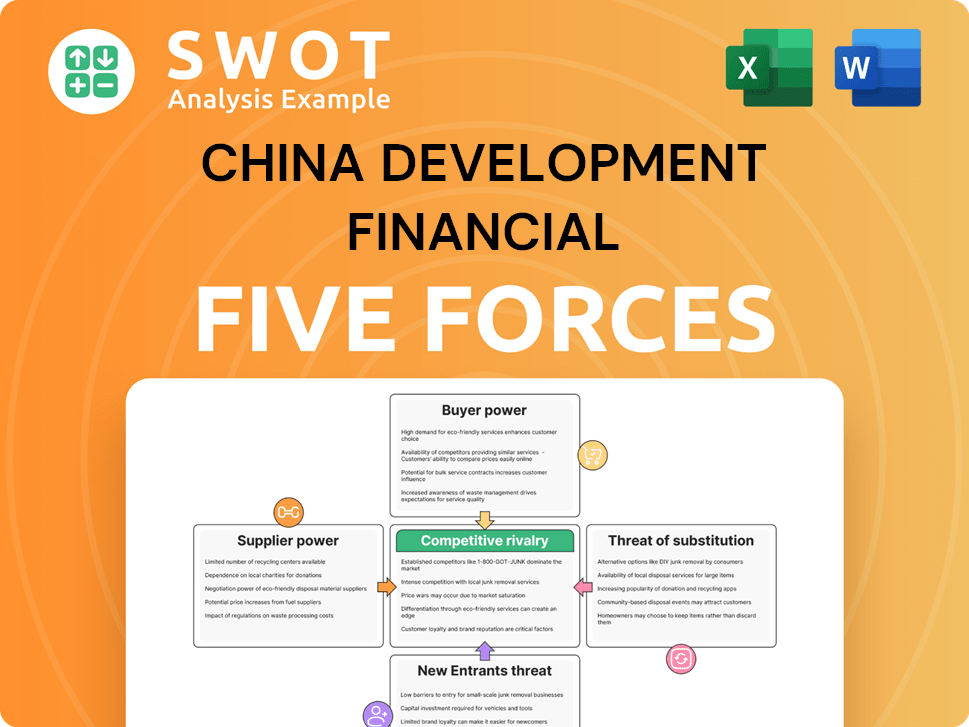
Related Blogs
- What are Mission Vision & Core Values of China Development Financial Company?
- What is Competitive Landscape of China Development Financial Company?
- What is Growth Strategy and Future Prospects of China Development Financial Company?
- How Does China Development Financial Company Work?
- What is Sales and Marketing Strategy of China Development Financial Company?
- What is Brief History of China Development Financial Company?
- What is Customer Demographics and Target Market of China Development Financial Company?
Disclaimer
All information, articles, and product details provided on this website are for general informational and educational purposes only. We do not claim any ownership over, nor do we intend to infringe upon, any trademarks, copyrights, logos, brand names, or other intellectual property mentioned or depicted on this site. Such intellectual property remains the property of its respective owners, and any references here are made solely for identification or informational purposes, without implying any affiliation, endorsement, or partnership.
We make no representations or warranties, express or implied, regarding the accuracy, completeness, or suitability of any content or products presented. Nothing on this website should be construed as legal, tax, investment, financial, medical, or other professional advice. In addition, no part of this site—including articles or product references—constitutes a solicitation, recommendation, endorsement, advertisement, or offer to buy or sell any securities, franchises, or other financial instruments, particularly in jurisdictions where such activity would be unlawful.
All content is of a general nature and may not address the specific circumstances of any individual or entity. It is not a substitute for professional advice or services. Any actions you take based on the information provided here are strictly at your own risk. You accept full responsibility for any decisions or outcomes arising from your use of this website and agree to release us from any liability in connection with your use of, or reliance upon, the content or products found herein.